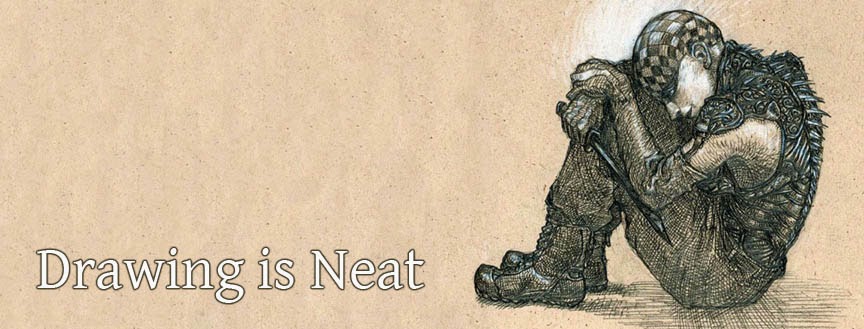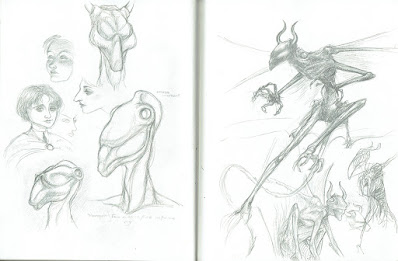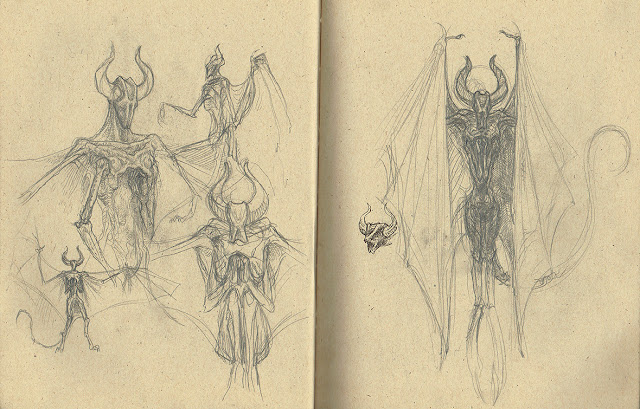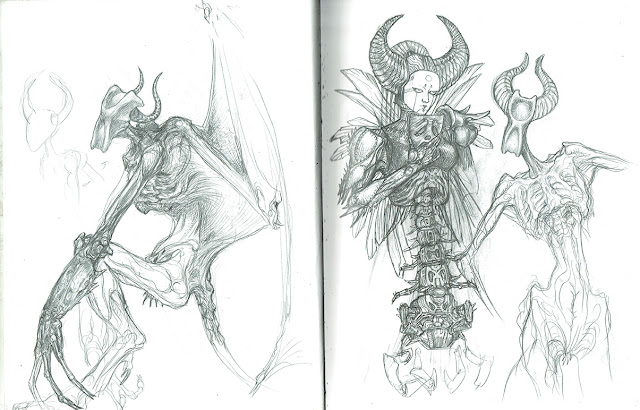"Suddenly, without a warning sound in the dark, Carter felt his curved scimitar drawn stealthily out of his belt by some unseen hand. Then he heard it clatter down over the rocks below. And between him and the Milky Way he thought he saw a very terrible outline of something noxiously thin and horned and tailed and bat-winged. Other things, too, had begun to blot out patches of stars west of him, as if a flock of vague entities were flapping thickly and silently out of that inaccessible cave in the face of the precipice. Then a sort of cold rubbery arm seized his neck and something else seized his feet, and he was lifted inconsiderately up and swung about in space. Another minute and the stars were gone, and Carter knew that the night-gaunts had got him."
- H.P. Lovecraft, The Dream Quest of Unknown Kadath, 1927
H.P. Lovecraft wrote of the night-gaunts in his poem "Night-Gaunts" and in the story "The Dream Quest of Unknown Kadath." He certainly had a vision of what they were and how they behaved because, as a child, he was tormented by them in his nightmares- which I'll talk about a bit later. They were later expanded upon in the writings of Brian Lumley, who hinted that they may have mouths with which to suckle Yibb-Tstll's black breasts.
The alternate title to this post could have been "Why I Hate Wings On the Backs of Humanoid Anatomy." For almost a quarter century I have struggled to come up with a feasible way that wings on a humanoid (while still retaining normal arms) could work and, for now, have concluded, like so many others, that it just doesn't- not with our bone structure and musculature, anyway. To carry the weight of the human body, the wings would have to cover an extremely large area, with a wing span of something like 25-30 feet. Now, the muscles needed to move such limbs would be immense, requiring additional bone area on the scapula and sternum- and these muscles and bones couldn't interfere with the existing arms. It just becomes ridiculous. Wings just growing out of shoulder blades always bothered me, even in the most beautiful depictions of angel or demon. For the purposes of fantasy, it really is best to ignore it and just plop those wings on there. What I am going to do, then, is take my very limited knowledge of physics and physiology and try my best to come up with a solution for a humanoid with wings while at the same time freely ignoring some of the complications.
If we can change the anatomical structure of the organism we're dealing with, we're given some anatomical leeway. You see, we're not dealing with a human, or even an earthly lifeform. In fact, we're not even dealing with something that is absolutely confined to the physics of this universe. The night-gaunt is a denizen of the H.P. Lovecraft's Dreamlands, and while it is a "real" place- just one separate from ours- it is fantastical, and while I won't be as lazy as to just say this or that happens or exists "because magic," I'm pretty sure it is exempt from at least some of the laws of physics. I mean, cats can jump to the moon- the Dreamlands moon with forests and oily seas on the dark side of it. The Dreamlands is a constantly changing world, formed by the dreams of the people of Earth. Other planets and realms have their own Dreamlands.
So, in no way would the night-gaunts that I draw "work." Lovecraft described them as "noxiously thin," so I wanted no musculature. The night-gaunts are black and rubbery, with a skin texture akin to a whale's. I picture them like a skeleton or demonic armature covered in oily latex, but with a bit of weathering here and there. The only loose flesh they have is the membrane of their bat-like wings. Lovecraft, again with the bat-like wings. It leaves room for artistic liberty, but this time I decided to stick with almost exactly a bat wing. Problem is, a real bat's wings are comprised of its two arms and the membrane goes all the way down to the ankles and then across to the tail. Night-gaunts have to have those two arms in addition to those wings.
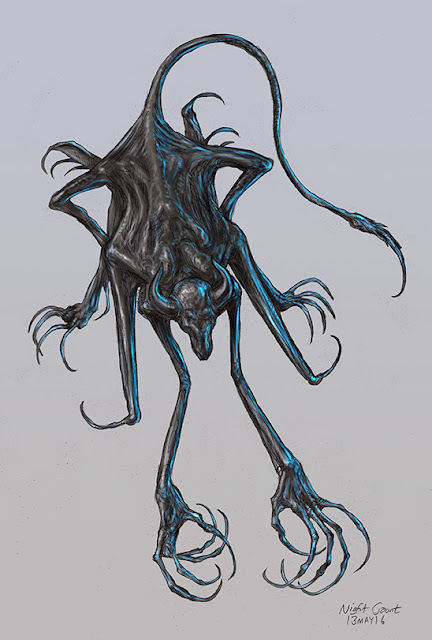 | |
|
Those Damned Wings: The problem with just attaching wings so that they just stick out the back of the shoulder blades is that, because there is an existing set of shoulders in the way, they would lack the clearance for the down sweep in the flapping motion. Now, if you watch this slow motion footage of a bat in flight from the Smithsonian Channel, you can see that while the wings don't down sweep to steeply, they still can't be blocked by the previously existing shoulders, lats, and rib cage, so the attachment point (where the humerus attaches to the scapula) has to be wide enough to accommodate this range of motion. It's basically like wearing a "wing pack" on one's back. Notice that even the legs and the tail/tail membrane are involved in the flapping motion in the video below.
Speaking of flapping, I've watched bats flying around in my parents' backyard on many a summer night. We used to throw pebbles into the air and watch them chase them for a bit. One time, my brother and I even tried bits of bologna, and I know at least one of them caught the piece- don't know if it ate it or not. Anyway, a bat's flapping sound, though quiet, is still audible. Lovecraft made a point of saying that the night-gaunts were completely silent, even in flight. Now, owls have special serrated feathers along the back edge of their wings to allow for near-silent flight, and that just doesn't work for membranous wings. Basically, I'm just going to attribute this to being a supernatural Dreamlands...thing.
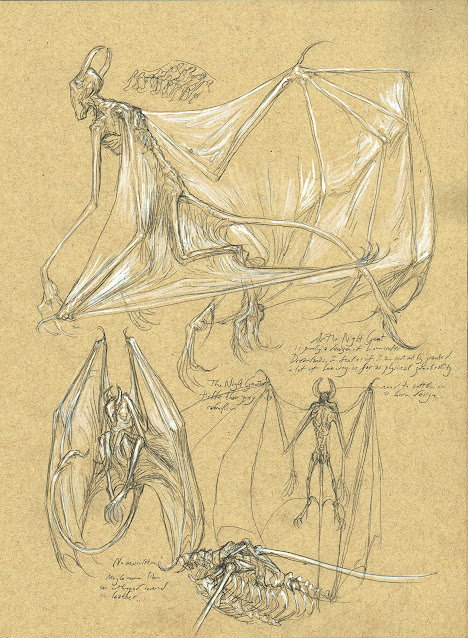 |
| The forward shoulders (the "normal" shoulders, if you will) on these sketches are too broad. The shoulders of the wings would have to extend out a bit further to allow a full range of motion. |
Assuming that the night-gaunt bone structure was light enough to allow for winged flight, it's still unlikely that they could carry the weight of a struggling human, but in the Dreamlands - and we might as well say in all of fiction- it is possible. I am confident we can all think of an instance where a winged man-thing has carried something about its own size aloft, so we're just going to have to let that go (even though I will not let the wings sticking out of shoulder blades thing go!). In Dream Quest, the night-gaunts were able to lift the toad-like moon beasts into the air. Now, the story never describes the size of the moon beasts, but I imagine them to be these heavy, blubbery things. It takes several night-gaunts to haul even one up into the air, and not always successfully: "Sometimes a group of the black flutterers would drop a toadlike prisoner from aloft by mistake, and the manner in which the victim would burst was highly offensive to the sight and smell." I love that.
 | |
|
For some reason, once the night-gaunts are no longer these fearsome shadow entities and take on the role of loyal soldier and transportation, they fly in pairs to carry our hero Randolph Carter and his ghoul allies through the sky. I'm assuming that this was for some sort of comfort, but I cannot figure out how this would work. It's really hard, if not impossible, for a pair of winged things to carry a singular object- not talking about something spread out like a tarp or a ribbon- without their wings interfering with each other. Take a look at this illustration from The Wizard of Oz, drawn by W.W. Denslow:
Now, it looks wonderful as an illustration, but there's just no way those flying monkeys could flap their wings without hitting each other or Dorothy. Still, I bet that what we see in the drawing is exactly what Lovecraft was thinking.
Now, in the drawings above, we can see that it still would probably be best for just one night-gaunt to carry one man or ghoul, though, I doubt that there would be a comfortable way to do this. In the first drawing, it's like the man is being held in baby-swing position, with the hands grasping the thighs from below and the back being supported by the forearms. The second drawing shows a tandem carry- with one night-gaunt behind or below the other. This...I suppose could work, though I don't know how efficient it is and it doesn't look very comfortable the way I've drawn it. In the third drawing, the night-gaunts have these tiny Final Fantasty Moogle wings, so they can fly side by side and not bump into each other. Okay, I haven't solved this at all and I'm not going to. Let's move on.
 |
| I imagine that the wing membrane wouldn't be so saggy looking as this, but I was using a hairless bat as reference and loved how the membrane looked. |
The Basic Shape: Lovecraft dreamed of the night-gaunts. Rather, he was tormented by them in dreadful nightmares, as described in a letter to friend: "When I was 6 or 7 I used to be tormented constantly with a peculiar type of recurrent nightmare in which a monstrous race of entities (called by me 'night-gaunts'—I don't know where I got hold of the name) used to snatch me up by the stomach...and carry me off though infinite leagues of black air over the towers of dead and horrible cities...The "night-gaunts" were black, lean, rubbery things with bared, barbed tails, bat-wings and no faces at all. Undoubtedly I derived the image from the jumbled memory of Doré drawings (largely the illustrations to 'Paradise Lost') which fascinated me in waking hours."
And then "...They had no voices & their only form of real torture was their habit of tickling my stomach...before snatching me up & swooping away with me. […] They seemed to come in flocks of 25 or 50, & would sometimes fling me one to the other." -I cannot find a copy of this letter or a complete transcript of it- only portions of it here and there. There are numerous books dedicated to the letters of Lovecraft to various friends.
I think that the silent, black, night-gaunts in Lovecraft's dreams were like winged nightmare shadows come to life. Of the tickling sensation, I can say that I have personally felt something like this- sort of an electrifying paralyzation that occurs in dreams- probably akin to dream paralysis (where certain motor functions have shut down during sleep but your mind is semi aware). It has happened to me while being attacked by some nondescript entity (a shadow or shape). I wonder if it's the same thing that Lovecraft was talking about.
When drawing the night-gaunt, I drew inspiration from a few things. Obviously, bats. The bat wing and the texture of the membrane was very important. Devil's purses, which I find on the beaches on the Jersey shore, have the perfect texture (when soaked) and these long, curly hooks on them, which made me think of claws adapted for tickling (I guess another design would be something that looked like a Koosh ball for a talon). I like the rubbery black texture of the beetle and I've always felt that the night-gaunts would have a wasp-like appearance with their elongated limbs, not to mention their behavior.
A Trip Down Night-gaunt Memory Lane: Now, I've been drawing night-gaunts for years (and not real well, mind you!). So, let me show you some of my early designs from way back there in the closet full of sketchbooks.
July, 1992: My first drawings of the night-gaunt were pretty typical. I think those horns would be considered outward pointing, so that's wrong. You can see by the bottom sketch that I'm already troubled with the wings on the back concept.
July, 1992: At this point, the head is just this ovoid shape. I'm starting to elongate the limbs, but the forms are still too thick, especially the tail.
First studies of bat wings and how they might apply to the night-gaunt. You can see that I basically just took the bat on the left and stuck it on the night-gaunt on the right. At this point, I even had a small set of pseudo legs extending from the hip so that the wing membrane could attach there.
January, 1993: I thought it might be interesting to add a bit of form to the head, but these camel-like designs are just funny looking. The two-thumbed design on the right is stolen directly- and badly- from Wayne Barlowe's Overlord design from Barlowe's Guide to Extra Terrestrials- one of my favorite books from my childhood.
1994: By this point, my night-gaunt designs began to take on more insectoid qualities. Wings have a barbed or serrated edge and the horns are still outward pointing.
1999: Introduction of the "x-faced" night-gaunt. Horns became larger and ridged. Was playing with the idea that the non-wing arms would be these arthropod limbs extending from either side of the chest which, when folded, would fit into the cavity under the sternum. I dunno.
1999: Okay, I have no real explanation for the one on the left, with its huge crustacean arm and muscular legs. The thing on the left side of the right page is just a doodle, but I kind of still like the night-gaunt on the right, although I could do without the massive hips/pelvis.
2000: A really clumsy handling of the wing limbs on the left, with both pages looking more towards pterosaur anatomy, Still sticking with the "x-face" design.
2000: Still pursuing the pterosaur wing design. The drawing on the right was supposed to be night-gaunts communicating through gesture, but I abandoned it on the grounds that it sucked.
2006: Doodles of the night-gaunt with the x-face becoming less pronounced. Also, studies for Baku, a Yokai from Japanese mythology. Yep, all those years later and the wing design was still no closer.
The Head: I don't have a real clear opinion of how the head should look. It seems like every time I draw one, the head is a bit different.
The interesting thing about drawing the head and neck of the night-gaunt, and one that I was constantly forgetting, is that this is a creature with no features, which meant that it had no nasal passages, no need for any musculature on the face, no mandible, no throat, and -supposedly- they were mindless. I don't think that necessarily means that they have no brains, but it is interesting to think that they are these just dream constructs, without any need for such things.
 |
| Night-gaunt skulls. |
I began to think of what their skulls might look like. I'm guessing that they would be these solid masses of bone, but it's also interesting to think of a skull being nightmare twisted. Like if you took a human skull and smeared it flat like it was made of clay. The remnants of features and divisions in the bone might still be visible, but maybe don't transfer to the skin that encases it.
Looking at my old drawings, the description of the night-gaunts being faceless immediately made me think of this smooth surface where a face would be. As time went by, I began to add hints of features or even features that could contradict a face. In the end, I think a blankness, like a phantom's face in stark shadow, is more appropriate. Right now- and I say this because my opinion may change in an hour- I even want to avoid the hints of a brow or cheekbones, as I have done in the previous drawings. Maybe it all goes back to the x-face. I still like that one.
The night-gaunt head is just one of these things that keeps changing in my mind, and I'm not sure why. With the inward curving horns: again, there's a lot of leeway, but we can take note that no special attention was paid to them, so we know that they probably weren't immense or elaborate. Right now, I'm partial to the second one in the top row in the sketch above.
The Hands: As the instruments of the night-gaunt's torturous tickling, at the last minute when starting the drawings for this post, I decided to make their fingertips- in fact the tips of all their extremities- these long wiry things, like the hooked ends of the Devil's Purses I find on the beach. I had considered- and with no justification from the source material- that they can extend and retract these hooks at will, but really only because when I look at them I think that they must be terribly bothersome when not tickling something.
 |
| Hands of a night-gaunt. Tips retracted. |
No matter what, long fingers and toes lend to the look of the night-gaunt, so I like them to be almost cartoonishly elongated.
Further Thoughts: I was going to do a whole section about the night-gaunts form of communication through gesture, but I felt that it was pretty self-explanatory and I wanted to finish this within the week. I do wonder what they would talk about, unless it's just directions of how to get to this or that, similar to how bees communicate to other bees the location of a flower (by wiggling their butts).
Even though the night-gaunts are mindless, there must be some continued order throughout the species, as they have certain enemies and allies and seem to know where things are in the world. I'm not going to go into night-gaunt reproduction because I have no idea and I don't think that Lovecraft ever even thought about that.
I find it curious that Lovecraft was tormented by the very thought of these winged beasts, but that in The Dream Quest of Unknown Kadath they are almost instantly made to be tame with the use of a secret password, which I bet Lovecraft himself had wished he had possessed when he was 6 years old.
